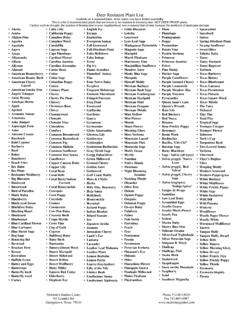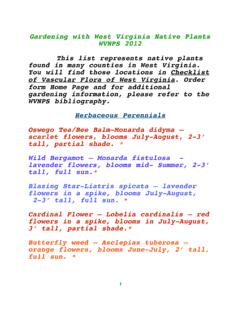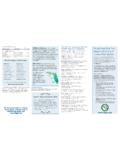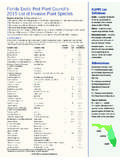Transcription of 2018 Plant List - Scioto Gardens Landscape Nursery ...
1 Key to Symbols: Full Sun Part Shade Full Shade Attracts Birds & Pollinators Fragrant Cut Flowers Fall Color Deer and Rabbit Resistant Native Species Medicinal Uses Edible Larval Host Page # 1 Scioto Gardens 740-363-8264 Note: Butterfly info mostly based on Doug Tallomy s research. Sustainable, earth-friendly growth and maintenance practices: Real Soil = Real Difference. All plants are container-grown in a blend of local soil and compost. plants are grown outside year-round. They are always in step with the seasons. Minimal pruning ensures a well-rooted, healthy Plant . Use degradable and recycled containers to reduce waste. Use of controlled-release fertilizers minimizes leaching into the environment. Our primary focus is on native plants . However, non-invasive exotics are an equally important part of the choices we offer you.
2 There is great creative opportunity using natives in combination with exotics. Adding more native plants into our landscapes provides food and habitat for wildlife and connections to larger natural areas. Additional species may be available. Email or call for current availability, sizes, and prices. Wetland Indicator Status This is listed in parentheses after the common name when a status is known. All species have not been evaluated. The indicator code is helpful in evaluating the appropriate habitat for a Plant . Please remem-ber plants don t read the books! There are many variables to consider. Indicator Code Indicator Status Comment OBL Obligate Wetland Almost always is a hydrophyte, rarely in uplands FACW Facultative Wetland Usually is a hydrophyte but occasionally found in uplands FAC Facultative Commonly occurs as either a hydrophyte or non-hydrophyte FACU Facultative Upland Occasionally is a hydrophyte but usually occurs in uplands UPL Obligate Upland Rarely is a hydrophyte, almost always in uplands 3351 State Route 37 West Delaware, OH 43015 Index: Trees & Shrubs pg.
3 2-8 Perennials pg. 8-18 Ferns pg. 19-20 Grasses pg. 18-19 Vines pg. 20-21 Edibles pg. 20 Hours: April 1 October 31: Sat. 9 am - 6 pm am - 5 pm Extended hours in May & June: Sat. 9 am - 7 pm am - 6 pm Open Holidays 10am - 5pm 2018 Plant List Phone/fax: 740-363-8264 Email: Key to Symbols: Full Sun Part Shade Full Shade Attracts Birds & Pollinators Fragrant Cut Flowers Fall Color Deer and Rabbit Resistant Native Species Medicinal Uses Edible Larval Host Page # 2 Scioto Gardens 740-363-8264 Note: Butterfly info mostly based on Doug Tallomy s research. Abies balsamea var. phanerolepis Canaan Fir Medium sized evergreen. A very popular Christmas tree. Common name from the Canaan Valley in WV where it was first found. Average soils - well drained or clay.
4 Best in slightly acidic soils. Tolerates heat, humidity, and drought. Full sun to light shade. 40' x 20-30' Eastern US native. Zone 3 Acanthopanax s. 'Variegatus' Variegated Arelia Beautiful variegated Plant with bright yellow and green palmate leaves. Great tough Plant for average to dry locations. Tolerates drought, shearing, urban pollution. Arching form. Small weak spines at the petioles. Japan. Very adapta-ble, grows in full sun to full shade. 5-8' x 5-8' Zone 4 Acer rubrum Red Maple (FAC) Good shade tree. Medium to fast growing. Excellent orange-red fall color. One of the first to color in fall. Monoecious. Host to 287 species of Lepidoptera. Best in slightly acidic soils. Average to moist soil. Tolerates air pollution. OH Native. 30-50' x 40-70' Full sun - part shade. Zone 3-9 Acer saccharum Sugar Maple (FACU) Excellent native shade tree.
5 Host to 287 species of Lepidoptera. A significant tree of the Eastern hardwood forest. Spectacular fall color. Sap is used to make maple syrup. Average soil. Intolerant of road salt, soil compaction & pollu-tion. OH native. Full sun to part shade. 40-80' x 30-60' Zone 3 Aesculus glabra Ohio Buckeye (FACU) The Ohio State tree. Whitish flowers in spring attract hummingbirds. Host to 32 species of Lepidoptera. A nice rounded form with low sweeping branches. Buckeyes tend to lose their leaves early and unceremoniously. Average soil. OH native. Full sun to part shade. 30' x 25' Zone 3 Aesculus pavia Red Buckeye (FACU) Small tree with nice rounded form. Brick red flower spikes in spring are great for hummingbirds. Host to 32 species of Lepidoptera. Average to dry soil. Salt tolerant.
6 Native to southern US. Full sun to part shade. 10-20' x 10-20' Zone 5 Amelanchier laevis Allegheny Serviceberry A small tree with white flowers in spring before the leaves emerge. Host to 115 species of Lepidoptera. Red fall color. Edible dark purple berries in June. Usual-ly multi-stemmed. Best in moist, well drained soil will tolerate average to dry. OH native. Full sun to part shade. 15-25' x 15-25' Zone 4 Aronia arbutifolia Red Chokeberry (FACW) White flower clusters in late spring, bright red glossy fruit, shiny foliage, and brilliant red fall color. Average to moist soil. Host Plant for 5 species of Lepidop-tera. A good rain garden Plant . Salt tolerant. Endangered species in OH. Full sun to part shade. 6-8' x 6' Zone 4 Aronia melanocarpa Black Chokeberry (FACW) Lovely white flower clusters in spring.
7 Black edible fruit for wildlife and humans. Host Plant for 5 species of Lepidoptera. Glossy foliage turns a brilliant red in fall. Average to wet soils. Great for rain Gardens . OH native. Full sun to part shade. 6' x 6' Zones 3-8 Aronia melanocarpa 'Iroquois Beauty' Iroquois Beauty Black Chokeberry (FACW) A beautiful dwarf form. Fragrant, white flowers in late spring. Dark, glossy green foliage. Black fruit and brilliant wine-red fall color. Average to moist soil. Great for rain Gardens . Cultivar of OH native. Full sun to part shade. 3-4' x 3-4' Zone 3 Aronia melanocarpa 'Viking' Viking Black Chokeberry (FACW) Lovely white flower clusters in spring. Large black edible fruit for wildlife and humans. Developed as an orchard Plant in Europe. Host Plant for 5 species of Lepidoptera.
8 Glossy foliage turns a brilliant red in fall. Average to wet soils. OH native cultivar. Full sun to part shade. 6' x 6-8' Zones 3-8 Asimina triloba Common Pawpaw (FAC) A popular native tree with large drooping leaves giving it a tropical look. Typically found as an understory tree. The nutritious fruit is fragrant with a banana flavor. Host to 12 species of Lepidoptera. Best fruit set with 2 plants . Colonizes. Best in moist, rich soils. Medicinal uses. Full sun to shade. 15-20' x 15-20'. Zone 5 Betula nigra River Birch (FACW) Handsome specimen tree. Exfoliating bark provides a nice winter effect. The most trouble free birch with excellent resistance to bronze birch borer. Host Plant for 413 species of Lepidoptera. Average to wet soil. Great rain garden Plant . Medicinal uses. OH native.
9 Full sun to part shade. 40-70' x 40-60' Zone 3 Betula nigra 'Little King' Little King Dwarf River Birch (FACW) Compact, rounded growth habit with glossy medium green foliage. Exfoliating bark makes a nice winter effect. Excellent resistance to bronze birch borer. Host Plant for 413 species of Lepidoptera. Average to wet soil. Great rain garden Plant . Medicinal uses. OH native. Full sun to part shade. 10' x 10' Zone 3 Buxus microphylla 'Wanford Page' Wanford's Dwarf Golden Boxwood Unique, colorful boxwood. New growth is a luminescent butter yellow. Foliage matures to green. Winter foliage is green with yellow variegation. Dwarf mound shape. Average to dry soil. Full sun to part shade. 3' x 3' Zone 5 Buxus sempervirens 'Variegata' Variegated Boxwood Dark green leaves with yellow edges.
10 Nice rounded form. Slow growing. Great for a spot of color in a semi-shady place. Average to dry soil. Medicinal uses. Full sun to part shade. 3-4' x 3-4' Zone 5 Buxus x 'Glenco' 'Chicagoland Green' Boxwood Compact spreading habit. Good winter color. Faster growing than 'Green Velvet.' Excellent hardiness. Has withstood lows of -22 to -32 F with no die back. Average to dry soil. Full sun to part shade. 2-3' x 2-3' Zone 4 Calycanthus floridus Sweet Shrub (FACU) Spicy fragrant, maroon flowers in May. Glossy green foliage is aromatic when crushed. Average to dry soils. Medicinal uses. Host to 2 species of butterflies and moths. Native to Eastern US. Extirpated in OH wilds. Full sun to part shade. 6-9' x 6-12' Zone 4 TREES AND SHRUBS Key to Symbols: Full Sun Part Shade Full Shade Attracts Birds & Pollinators Fragrant Cut Flowers Fall Color Deer and Rabbit Resistant Native Species Medicinal Uses Edible Larval Host Page # 3 Scioto Gardens 740-363-8264 Note: Butterfly info mostly based on Doug Tallomy s research.





